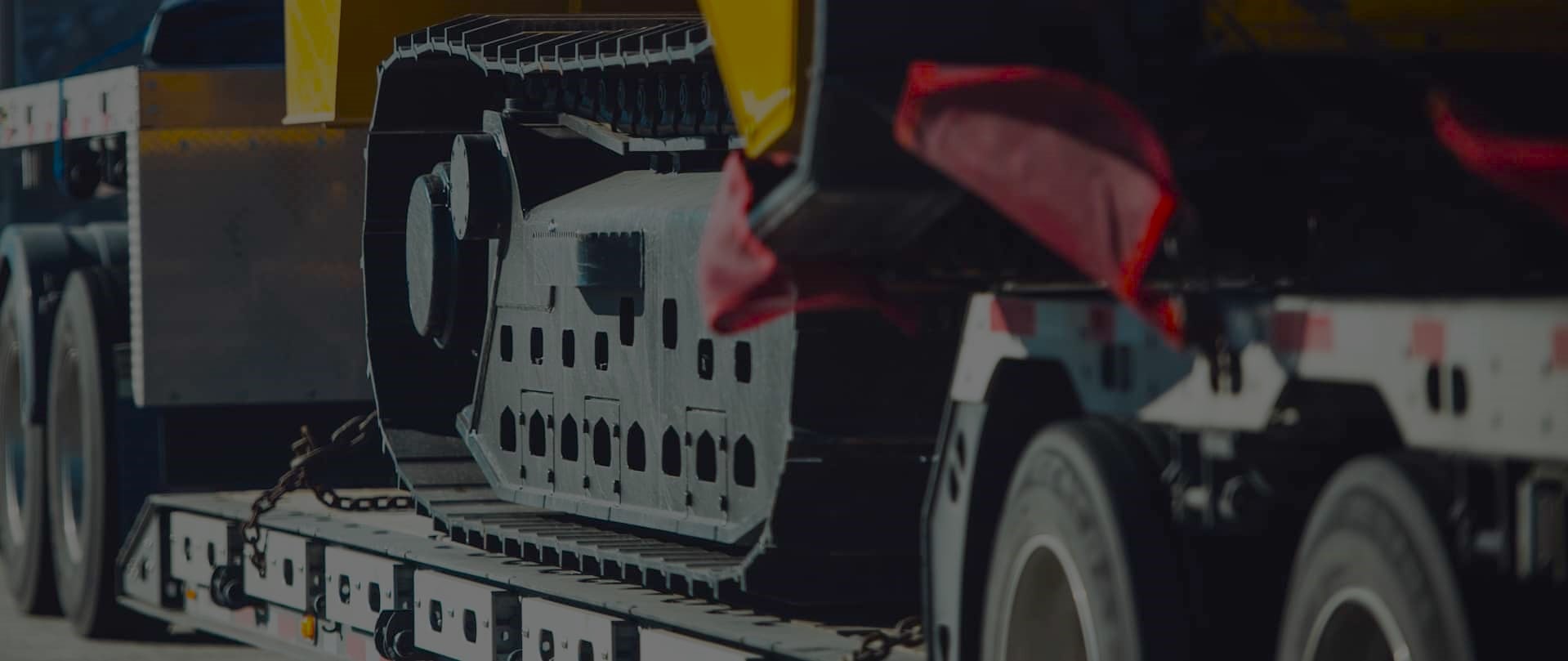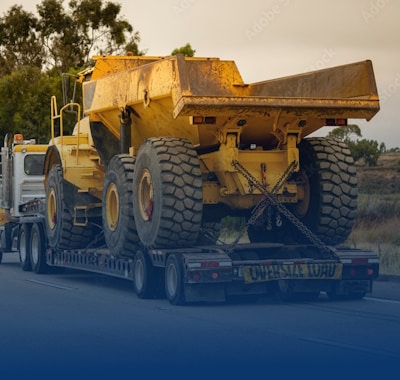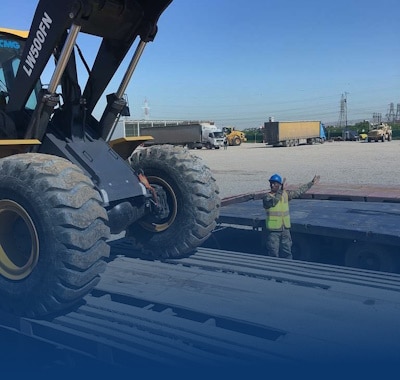Ensuring Safety While Transporting Heavy Military Equipment
Freedom Heavy Haul can offer expedited Pickup and Delivery for any size shipment anywhere in the USA. Contact us today for No Hassle, No Pressure Pricing.
Transporting heavy machinery requires careful planning and execution. Every step, from inspection to unloading, plays a critical role in keeping the process smooth and secure. We understand the risks involved and aim to guide you through the best practices to manage these challenges effectively.
Proper preparation is key. This includes thorough checks of the vehicle, trailer, and gear. Route planning is equally important, as it helps avoid potential hazards on the road. Our team emphasizes the use of safety protocols and protective measures to minimize risks during transport.
For example, Freedom Heavy Haul highlights the importance of driver training and weather considerations. These steps ensure that the equipment reaches its destination safely. By following these guidelines, you can reduce the likelihood of damage or delays.
We are committed to providing reliable solutions for transporting heavy machinery. Our focus is on maintaining the condition of your equipment and ensuring the safety of everyone involved. Let us help you navigate this complex process with confidence.
Understanding the Critical Role of Safety in Heavy Equipment Transport
Safety is the foundation of every successful heavy equipment transport operation. Without it, the risks of accidents, delays, and damage increase significantly. We prioritize safety to protect both personnel and machinery, ensuring every task is completed efficiently and securely.
Proper safety measures prevent accidents and reduce risks during transport. This includes thorough inspections of vehicles, trailers, and gear. Qualified personnel play a vital role in managing these operations, ensuring all protocols are followed.
Key safety practices include:
- Conducting detailed risk assessments before every transport.
- Documenting procedures to maintain consistency and accountability.
- Training drivers and team members to handle equipment safely.
Teamwork is essential in this process. A well-coordinated team ensures that all equipment is handled with care, from loading to unloading. Clear communication and proper planning further enhance the safety of the operation.
We emphasize the importance of using the right tools and measures for each task. This includes securing loads, checking weight distribution, and planning the safest route. By following these guidelines, we keep both personnel and machinery safe throughout the journey.
Our expertise in heavy equipment transport allows us to provide clear, actionable safety guidelines. We are committed to delivering reliable solutions that prioritize safety and efficiency. Let us help you navigate this complex process with confidence.
Pre-Transport Safety Measures and Preparation Protocols
Effective preparation is the cornerstone of successful equipment transport. Before any machinery hits the road, it’s crucial to implement pre-transport measures that minimize risks and ensure smooth operations. We focus on two key areas: conducting documented risk assessments and outfitting teams with the right gear.
Conducting Documented Risk Assessments
Risk assessments are a vital part of the preparation process. They help identify potential hazards and outline steps to mitigate them. A thorough assessment includes:
- Timeline Review: Mapping out the entire operation from loading to unloading.
- Hazard Identification: Spotting risks like road conditions, weather, or equipment size.
- Mitigation Strategies: Developing plans to address identified risks.
Documenting these steps ensures accountability and provides a clear reference for the team. It also helps maintain compliance with industry regulations.
Outfitting Teams with Proper PPE and Gear
Personal protective equipment (PPE) is essential for keeping personnel safe during transport. Every team member should have access to the right gear, including:
| Item | Purpose |
|---|---|
| Hard Hats | Protect against head injuries |
| Safety Gloves | Prevent hand injuries during loading |
| High-Visibility Vests | Ensure visibility on the road |
| Steel-Toe Boots | Protect feet from heavy loads |
Proper training on PPE use is equally important. It ensures that every person knows how to use their gear effectively, reducing the risk of accidents.
By following these preparation protocols, we ensure that every piece of equipment is managed safely. Proper planning not only enhances compliance but also reduces liability risks during transport. Let us help you implement these measures for a seamless and secure operation.
Inspecting Vehicles, Trailers, and Equipment for Safe Transport
Before hitting the road, inspecting every part of the transport setup is crucial. A detailed examination of the vehicle, trailer, and equipment ensures everything is in optimal condition. This step minimizes risks and keeps operations running smoothly.
Checking Tires, Brakes, and Lighting Systems
Tires are a critical component of any transport. We check for proper pressure and wear to avoid blowouts or delays. Regular inspections ensure tires can handle the load and weight of the machinery.
Brakes and lighting systems are equally important. Faulty brakes can lead to accidents, while malfunctioning lights reduce visibility. We make sure these systems are fully operational before every trip. This attention to detail prevents equipment failures during transit.
Experts agree that thorough inspections are the best way to maintain compliance with safety standards. Addressing any issues in advance reduces the risk of accidents and keeps the driver and team safe.
By following these steps, we ensure that every vehicle and trailer is ready for the journey. Proper inspections are not just a requirement—they are a cornerstone of successful equipment transport.
Best Practices for Loading Heavy Machinery Safely
Loading heavy machinery demands precision and teamwork to avoid mishaps. A well-planned process ensures that equipment is secured properly and ready for transport. We focus on clear roles, clean workspaces, and methodical steps to make every loading operation smooth and safe.
Designating Clear Team Responsibilities
Assigning specific roles to each team member is crucial. A spotter guides the driver, ensuring the machinery aligns perfectly with the trailer. Clear communication between team members prevents errors and keeps everyone safe. This approach minimizes the risk of accidents during the loading process.
Ensuring Clean and Level Loading Areas
Before starting, verify that the loading area is clean, level, and free from debris. A stable surface ensures that equipment moves smoothly onto the trailer. We recommend inspecting the area for any obstacles that could interfere with the process. A well-prepared workspace is the foundation of safe loading.
Starting the machine-ramp line-up slowly and methodically is another key step. This reduces the chance of load shifting and potential accidents. Adhering to set guidelines ensures that every piece of equipment is handled with care. For more insights on safe transport practices, visit Freedom Heavy Haul.
By following these best practices, we ensure that heavy equipment is loaded safely and efficiently. Every step taken is crucial for successful equipment transport. Let us help you implement these strategies for a seamless operation.
Ensuring Safety While Transporting Heavy Military Equipment
Planning the journey is as important as the transport itself. A well-thought-out route ensures that equipment reaches its destination without delays or damage. We focus on detailed planning to minimize risks and maximize efficiency.
Mapping the Optimal Route
Choosing the right path is crucial for a smooth transport process. We assess roads, bridges, and potential hazards to avoid unexpected obstacles. This step ensures compliance with safety regulations and reduces the risk of accidents.
Technology plays a key role in route planning. GPS and mapping tools help us identify the safest and most efficient paths. These tools also allow us to monitor real-time conditions, ensuring the journey stays on track.
Scheduling Regular Check-Ins
During long hauls, regular check-ins are essential. They help monitor the condition of the equipment and the well-being of the driver. We use communication tools to stay connected and address any issues promptly.
Check-ins also provide updates on the load and weight distribution. This ensures that the vehicle remains stable throughout the journey. Regular updates keep the process transparent and secure.
| Key Aspect | Benefit |
|---|---|
| Route Planning | Minimizes obstacles and ensures compliance |
| Technology Use | Provides real-time updates and safer paths |
| Regular Check-Ins | Monitors equipment and driver safety |
Every precaution taken in planning the route contributes to a secure and seamless transport experience. We are committed to delivering reliable solutions that prioritize efficiency and safety.
Communication, Signage, and Monitoring Throughout the Journey
Clear communication and proper signage are vital for a smooth transport process. They ensure that everyone involved is informed and aware of potential risks. We prioritize these elements to maintain a secure environment for both the crew and road users.
Using Safety Signs, Labels, and Lighting on Transport Vehicles
Large safety signs and labels are essential for alerting other drivers. They make it clear that a vehicle is carrying oversized or heavy equipment. Enhanced lighting, such as flashing beacons, further increases visibility, especially during low-light conditions.
Real-time monitoring tools like GPS and communication devices keep the team connected. These tools allow for immediate adjustments if conditions change. As noted by the Federal Highway Administration, advanced systems improve coordination and reduce risks during transport.
“Well-marked vehicles and consistent communication are the backbone of safe transport operations.”
Thorough communication protocols reduce confusion and enhance efficiency. For example, radios or mobile apps enable instant updates between the driver and support team. This ensures that everyone is on the same page throughout the journey.
| Key Element | Benefit |
|---|---|
| Safety Signs | Alert other drivers to oversized loads |
| Enhanced Lighting | Improve visibility in low-light conditions |
| Real-Time Monitoring | Enable quick adjustments to changing conditions |
Consistent monitoring and adjustments are crucial as conditions change. For more insights on best practices, visit Freedom Heavy Haul. By following these guidelines, we ensure a secure and efficient transport process.
Protocols for Unloading and Securing Equipment Post-Transport
The final stage of equipment transport is just as critical as the journey itself. Proper unloading ensures that machinery remains in optimal condition and that all personnel stay safe. We follow a systematic approach to make this process seamless and secure.
Performing Final Walkthroughs and Inspections
Before unloading, we conduct a thorough walkthrough of the vehicle and trailer. This step helps verify that the equipment is still properly secured and undamaged. Inspections include checking tie-downs, ramps, and the surrounding area for hazards.
Our team documents every inspection to maintain accountability. This practice ensures compliance with industry regulations and provides a clear record of the transport process. For more details on heavy equipment transportation, visit GoMotive.
Implementing Controlled Unloading Procedures
Unloading equipment requires precision and coordination. We use a step-by-step procedure to minimize risks. This includes aligning the ramp, slowly releasing tie-downs, and monitoring the load as it moves off the trailer.
Only essential personnel are involved in this process. A clean and secure area ensures that the equipment is handled safely. Clear roles and communication further enhance efficiency during unloading.
| Step | Benefit |
|---|---|
| Align Ramp | Ensures smooth movement of equipment |
| Release Tie-Downs | Prevents sudden shifts or damage |
| Monitor Load | Keeps equipment and personnel safe |
These protocols not only secure the equipment but also set the stage for documenting the successful completion of the transport process. For additional insights on safe unloading protocols, refer to Freedom Heavy Haul.
Wrapping Up the Heavy Equipment Transport Process Safely
Successful transport of large machinery hinges on meticulous planning and execution. From pre-transport checks to final inspections, every step plays a vital role in ensuring a smooth and secure process. We emphasize the importance of documenting each phase to maintain accountability and set industry best practices.
Every stage, from loading to unloading, is critical. Proper planning, continuous monitoring, and adherence to protocols keep both equipment and personnel safe. Our expert guidelines are designed to help companies maintain high standards of compliance and efficiency.
We are committed to providing reliable solutions for transport needs. By following these steps, you can ensure that your vehicle and load reach their destination without issues. Let us help you navigate this complex process with confidence and expertise.







